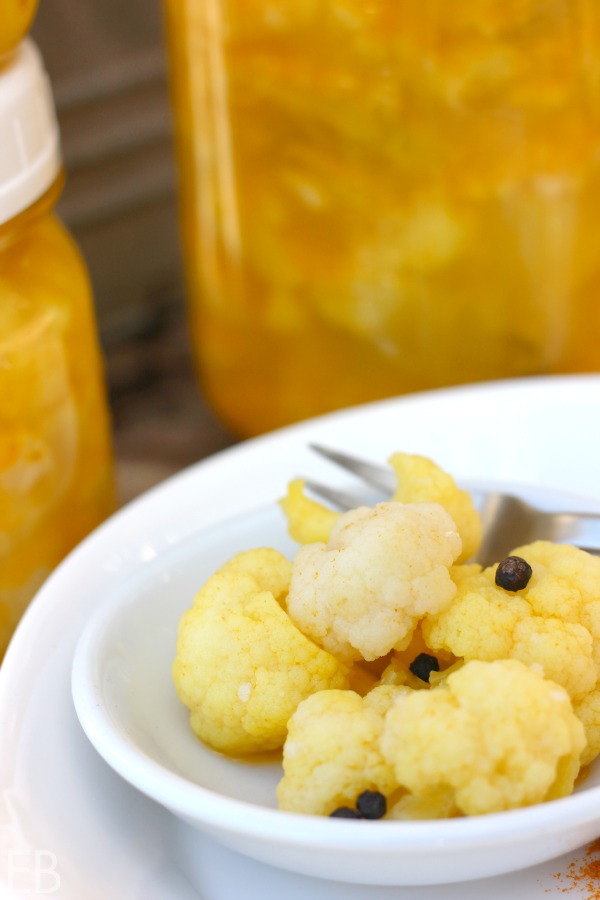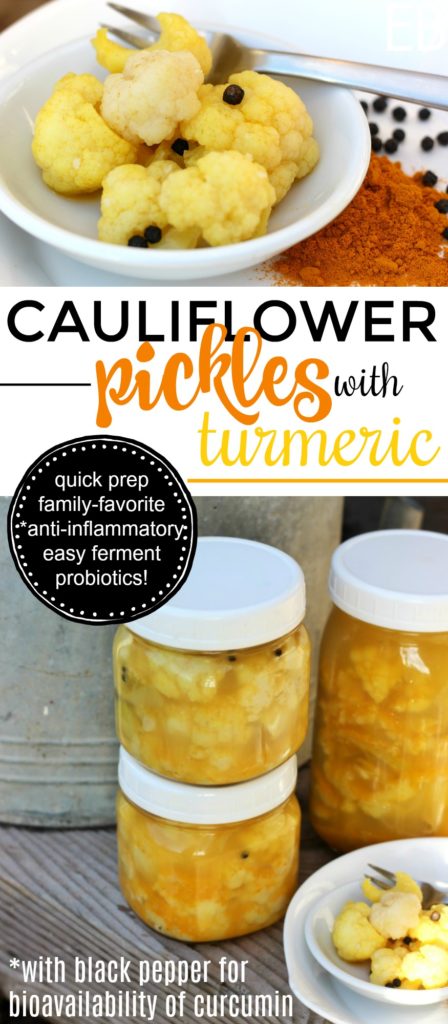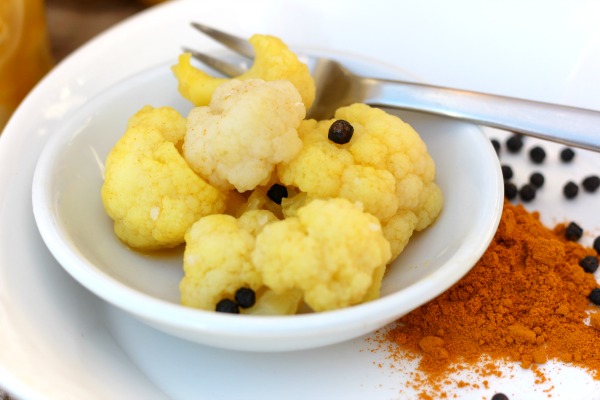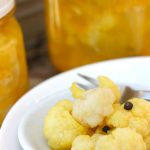I may receive a commission if you purchase through links in this post. I am not a doctor; please consult your practitioner before changing your supplement or healthcare regimen.
Cauliflower Pickles are my favorite vegetable ferment. I love their texture. And I love how they compliment the flavor of turmeric and/or curry. You’ll love this healthy condiment too — that’s full of probiotics, fun to make and anti-inflammatory!

Anti-Inflammatory
This recipe can have just 5 ingredients: warm water, sea salt, cauliflower, turmeric and black pepper. The black pepper makes the active ingredient in turmeric, curcumin, more bio-available. Small, regular amounts of bioavailable curcumin in the diet have an anti-inflammatory effect. (AIP folks can leave the black pepper out.)
Pickles with turmeric
Curcumin is magnified through fermentation! And condiment portions of fermented foods are the perfect ratio for curcumin to be effective. It’s odd but true: turmeric must be eaten with black pepper, fat, often, and in small amounts to work!
So yes, eat this beautiful ferment regularly with the lovely meals you make, meals that contain fat. Then you have all the necessary components for it to be anti-inflammatory.
And, of course, homemade fermented pickles contain probiotics, which are also anti-inflammatory.
In Recipe Notes below I give links to my two favorite fermentation tools, to make the process easy, successful, and therefore, rewarding and fun!
Variations on Cauliflower Pickles with Turmeric
If you like, I give a few additional ingredients below that can be added in; I love these: curry powder, raisins, lemon zest, cayenne, garlic and ginger. Choose just one of them or all of them. They make cauliflower shine. SUCH an exciting arena of flavors.

Cauliflower Pickles with Turmeric and Black Pepper {Fermented Cauliflower, Anti-Inflammatory}
Ingredients
- 4 cups warm water filtered (not tap water or chlorinated water)
- 2 heads cauliflower chopped into small florets
- 4 Tablespoons sea salt
- 1 teaspoon turmeric
- ½ teaspoon black peppercorns or freshly ground black pepper
- ½ teaspoon curry powder optional
- to taste Additional optional ingredients include: mustard seeds, unwaxed lemon rind, raisins, cayenne, fresh ginger and garlic
Instructions
- In large dish with pour spout whisk together the turmeric powder, optional curry and a small portion of the warm water (about 2 tablespoons), to create a kind of runny paste. Add remaining water and sea salt, stir to dissolve. Set aside.
- Place cauliflower florets into preferred fermenting container(s). Pack pieces in tightly (to the neck if using canning jars). Add peppercorns.
- Pour spiced, salted water over cauliflower. Press firmly on solids, so water rises above and air bubbles are released. You want the brine to come about 1/2-1 inch above the cauliflower pieces but still leave 1 inch headspace if using jars.
- Weight with fermenting weights (see link below in Recipe notes) or preferred weight.
- Lightly seal lid(s), and place in warmest location possible for 7-14 days, depending on warmth of location. Check the veggies every 2 days or so to make sure they're staying below the brine.
- They're done when the liquid is no longer very bubbly, when the cauliflower is nicely tart/vinegary, to your taste.
- Transfer to refrigerator, and serve as a condiment. The flavor will continue to improve and develop. Any extra brine you don't wish to drink can be used to ferment in other recipes. (See my Sourdough Grain-free Waffle recipe. The brine is used to reduce phytates in cassava flour. It's great to have extra brine on hand!)



Oh Snap! Let's Eat! says
I’ve never fermented cauliflower before… but I have tried some pickled cauliflower before and DAYAM it was delish!
Megan Stevens says
Ha, awesome; yep, it’s so good!
Renee Kohley says
I haven’t made fermented cauli in a long time – and this version with the turmeric looks amazing! Thanks for the inspiration!
Megan Stevens says
You’re welcome; thanks! Enjoy! 🙂
Jean says
I never thought to pickle cauliflower before but this sounds so delicious! I’ll definitely have to try this out.
Megan Stevens says
Yay, I’m so glad!!
Kari Peters says
These would make such a fantastic side dish to so many Asian and Indian inspired meals, thanks for such a great recipe!
Megan Stevens says
Oh, I love that idea!! YUM! Two of my favorite kinds of foods…! Thank you!
Melissa @RealNutritiousLiving says
The look like a must make! I’ve never used weights or a ferment crock before. You’ve definitely peaked my interest!
Megan Stevens says
Oh good, it’s such a fun process and becomes a way of life. You’ll love it!
Carrie @ Clean Eating Kitchen says
I’ve made quick pickled veggies, and this looks easy and even healthier. Yay!
Megan Stevens says
Yay, so glad! Yes, it’s easy and rewarding!
Cristina Maria Curp says
Oh em gee!!!! Cauliflower is life! I need to make this!
Megan Stevens says
LOL! Ha, love it; enjoy! 😉
Katja Heino says
Oh, I need to make this. Cauliflower is something I have not fermented. YUM!!
Becky Winkler says
So cool! I’d love to try fermented cauliflower!
Kira says
How long do they last in refrigerator?
Megan says
Many months or longer. 🙂
Steff says
Do I need weights if I have fermenting lids that I pump the air out with?
Megan says
Hi Steff, yes, the weights are usually still needed and helpful to keep the solids under the brine. However, if you can keep everything under without, then that’s fine, like by using a small neck mason jar and larger pieces of veggies that tuck under that lip.
Abigail says
My first batch of these is done fermenting (I think). No more bubbles. I used a pickling crock with stone weights to keep the cauliflower down in the water. The liquid above that did have a bit of mold/scum on it. I this normal? Safe to still eat my cauliflower after removed? Also – the taste is still more salty than sour. Maybe the ferment isn’t finished? The liquid is thick and actually I’d say stringy or gelled a bit. Is this normal?
Megan says
If the cauli tastes good to your taste, both the crispness and saltiness, then you’re good to go. The scum on top is Kahm yeast and harmless. The risk with continuing to ferment is that it will begin to taint the flavor. The gelled texture is also not a problem, as long as the ferment smells and looks good and isn’t slimy. If you like, one final option is to create a fresh salt brine: Pack the pickled cauliflower into fresh jars, top with brine, and put in fridge as long as you like. It will continue to slow-ferment.